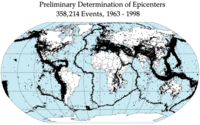
Photo from wikipedia
Abstract Molecular dynamics method is used to investigate the dynamic response of void-included aluminum under three loading patterns, which are constant strain rate, constant-stress Hugoniostat and direct shock loadings. The… Click to show full abstract
Abstract Molecular dynamics method is used to investigate the dynamic response of void-included aluminum under three loading patterns, which are constant strain rate, constant-stress Hugoniostat and direct shock loadings. The simulations show a very weak dependence of the dynamic response on the loading patterns under weak loadings, where appears a similar dislocation distribution originated from the initial void. When the pressure exceeds 13.3 GPa, the homogeneous dislocations will appear for the direct shock loading, whose growth can lead to intersections and then hinders the relaxation of the shear stress to some extent. Besides, we also observe the transformation from FCC to HCP when the loading pressure exceeds 33.5 GPa, whose effect on the shear stress is very significant. For the other two loadings, the dislocations still firstly originate from the void and then grow into symmetrical dislocation bands along the {111} planes, whose effect on the shear stress is not significant. Finally, we provide the adjusted parameter (damping coefficient of stress) for the constant-stress Hugoniostat method with a wide range of shock pressure, which can agree with the results from the direct shock for the void-included sample. These results are important reference for the application of the constant-stress Hugoniostat method in defective metals.
Journal Title: International Journal of Mechanical Sciences
Year Published: 2020
Link to full text (if available)
Share on Social Media: Sign Up to like & get
recommendations!